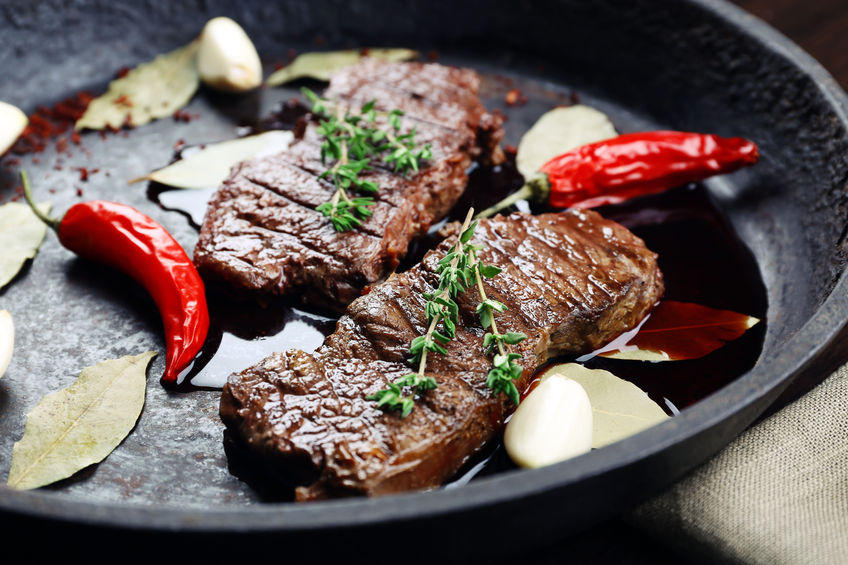Let’s not draw out the suspense. Here are our four winners, followed by an explanation why we chose these oils and not the others:
- Coconut oil
- Avocado oil
- Ghee / Clarified butter
- Light (processed) olive oil (i.e. not extra virgin)
- (Grass-fed) Lard/Tallow
So what determines good frying oil? Basically two main aspects:
- Smoking point
- Ratio of saturated and monounsaturated fatty acids (SFAs and MUFAs) compared to polyunsaturated fatty acids (PUFAs)
What Is a Smoke Point
This is the point where the fat starts to break down chemically, forming dangerous substances, e.g. free radicals or acrolein, the chemical responsible for that distinctive burnt smell and taste. Every fat has its (general) smoking point which helps you choose which purpose it is best suited for. But bear in mind that the longer you are using the oil, the lower its smoking point becomes. This is a fact which also speaks against reusing oils many times. Provided that you always filter out the solid bits after each frying, you can re-use your oil (provided you have chosen a good, stable fat as above) perhaps 5 times.
Generally speaking, pan frying usually happens around 250 F / 120 C, while deep frying takes the oil up to 320-355 F / 160 – 180 C.
Saturated, Monosaturated and Polyunsaturated Fatty Acids
We’ve been warned time and again that saturated fatty acids are bad for us – their consumption can lead to higher blood cholesterol etc. That is why red meat, lard etc. get such a bad reputation. But when it comes to choosing good frying oil, saturated and monosaturated fatty acids (SFAs and MUFAs) are what you want. Unlike polyunsaturated fatty acids (PUFAs), they are less prone to oxidization (they don’t form bonds with oxygen so much) when heated – their bonds are more stable, which is ultimately good news for your health.
And Now More About the Winners
- Coconut Oil
With 92% of saturated fatty acids and a very high smoking point, it’s the obvious choice. There are two versions available to you – virgin, which has slightly lower (but still very good) smoking point and lends a definite hint of coconut flavor to your food – or deodorized coconut oil. That coconut taste of virgin oil might be OK for you – some say they don’t even notice it, but it might be a consideration when frying for instance schnitzels.
Most deodorized coconut oils are or refined, bleached and deodorized and many advise against it. But they do have a longer shelf life, are even more stable and if you choose a good producer or go organic, the oil is likely to have been handled with natural methods (e.g. the bleaching is done by clay) and will still be a good choice for your kitchen. You should definitely avoid hydrogenated coconut oil though – any hydrogenated fact is bad news for your arteries.
This oil is very stable and unopened has a very impressive shelf life. It doesn’t have to go in the fridge, but if you aren’t using it that often (i.e. if you wouldn’t use up an opened container within 60 days), maybe take out a manageable portion, put it in a dark glass container and store this on your shelf while keeping the rest of the opened packaging in the fridge. You can keep it in the fridge altogether, but this will make the oil very hard to get out and you will unexpectedly combine cooking with fitness sessions.
- Avocado
With high smoking point and a good portion of MUFA (70%) and SFA (12%), this is a good option both for salads, and for the occasional frying. It has a very mild nutty taste that won’t distract from the taste of your food. It is a bit on the pricey side.
Avocado oil can be stored opened in your pantry for 6-8 months. If you think you’ll need longer (you’d probably have to have a tanker full of the stuff, but OK, we’re not judging), you can put it in the fridge where it can stay for 9-12 months.
- Ghee/Clarified butter
Butter is a good fat for frying, but it contains milk proteins and sugars and these burn very quickly, giving butter a bad taste when it’s been heated too much. Solution to this is ghee – or clarified butter, which has the milk proteins and sugars removed – good news if you have a milder form of lactose intolerance. When you buy ghee in a store it can get quite expensive, but you can easily make clarified butter – the next best thing – yourself, there are many video guides available. Ghee/clarified butter has very good smoking point and good levels of SFA (62%) and MUFA (29%).
If possible, opt for grass-fed ghee (or grass-fed butter, such as Kerrygold, when making your own). Fats produced by grass-fed animals have higher levels of saturated fatty acids and contain many more nutrients highly beneficial to your health.
Since ghee had its milk proteins removed, it won’t go rancid so easily and can live for some time outside the fridge, but it’s generally recommended to keep it refrigerated.
- Light Olive Oil
Light here basically means processed or refined. It gives olive oil higher stability (good smoking point), neutral taste and makes it a good choice for frying, even though you’d still go for extra virgin come salad time. The refining process strips away most of the vitamins, minerals and taste, so even though it is a good frying and cooking oil, be aware that this is not the oil they talk about when they praise the many benefits of olive oil.
You can store your olive oil in the pantry, but best in a dark place (or dark glass container), away from heat sources such as the stove. You can also put it in the fridge.
- Lard/Tallow
Good ratio of SFA and MUFA, high stability, good smoking point – and great taste for savory food. As mentioned above, it is always good to go for grass-fed lard/tallow. Aside from the fact that it’s better for the animals, it is higher in SFAs and lower in PUFAs and offers other health benefits.
In airtight (preferably glass) containers, tallow and lard can survive on the shelf, but we recommend the fridge, definitely once you’ve opened and started using them.
| Smoking point | SFA/MUFA/PUFA % | Notes | |
| Avocado (refined) | 520-570 F / 270-300 C | 13 / 67 / 13 | Good choice |
| Safflower – high oleic | 510 F / 265 C | 8 / 75 / 12 | |
| Rice Bran | 490 F / 260 C | 20 / 39 / 35 | |
| Green tea seed oil (NOT tea tree) | 485 F / 250 C | 21 / 54 / 25 | Good choice |
| Olive (refined/light) | 465 F / 240 C | 14 / 73 / 11 | Good choice |
| Soybean | 450 F / 230 C | 14 / 21 / 57 | Most US soy plants is GMO |
| Peanut | 450 F / 230 C | 17 / 57 / 21 | |
| Ghee (clarified butter) | 450-480 F / 230-250 C | 60-65 / 30 / 4 | Good choice |
| Corn | 410-450 F / 210-230 C | 14 / 29 / 57 | |
| Sunflower high oleic (70%+) | 450 / 232 | 10 / 84 / 4 | Can be good choice |
| Sunflower | 440 F / 225 C | 10 / 57 / 25 | |
| Margarine | 410-430 F / 210-220 C | 21 / 17 / 43 | |
| Coconut (refined) | 400 F / 250 C | 92 / 7 / 0 | Good choice |
| Vegetable (mix of various oils) | Varies, but generally over min. 400 F / 205 C | Varies depending on oils used | |
| Tallow (beef fat) | 400 F / 250 C | 50 / 42 / 4 | Good choice – but preferably grass-fed |
| Canola | 400 F / 250 C | 7 / 64 / 29 | |
| Macadamia | 390 F / 195 C | 17 / 73 / 3 | Good choice |
| Grapeseed refined | 420 F / 215 C | 11 / 21 / 64 | |
| Grapeseed | 390 F / 195 C | 7 / 21 / 71 | Not a good choice. In the drying process the seeds can come in contact with combustion gases, studies have shown high levels of carcinogenic PAH (polycyclic aromatic hydrocarbons) in some samples. Also contains high level of PUFAs. |
| Avocado (extra virgin) | 375-400 F / 190-250 C | 13 / 60 / 17 | |
| Lard (pork fat) | 370 F / 185 C | 39 / 45 / 11 | Good choice – but preferably grass-fed |
| Chicken fat | 375 F / 190 C | 20 / 45 / 31 | |
| Duck fat | 375 F / 190 C | 33 / 49 / 13 | |
| Vegetable shortening | 360 F / 180 C | 25 / 21 / 50 | |
| Coconut (virgin) | 350-385 F / 175-195 C | 93 / 7 / 0 | |
| Butter | 300-350 F / 150-175 C | 50 / 21 / – | |
| Sesame | 350 F / 175 C | 14 / 43 / 43 | |
| Extra Virgin Olive Oil | 325-375 F / 165 – 190 C | 14 / 71 / 11 |
Sources: USDA, Macrothink Institute, Wikipedia, paleohacks.com, jonbarron.org, marksdailyapple.com
Final Note – What About Hydrogenated Fats?
Just as general recommendation, try to stay away from hydrogenated (hardened) fats. Hydrogenation is basically turning unsaturated bonds into saturated by forcing hydrogen atom into the free (unsaturated) spaces. This is why they are thereafter called trans fatty acids. The hydrogenation process turns vegetable oils into solid blocks – and your arteries into battle ground, and lead to other health problems.
We hope you will enjoy your fried food in good health and cheerful mood!




